One leading British virologist,
Professor John Oxford at Queen Mary Hospital, University of London, and a
world authority on epidemics, warns that we must expect an
animal-originated pandemic to hit the world within the next five years,
with potentially cataclysmic effects on the human race.
Such
a contagion, he believes, will be a new strain of super-flu, a highly
infectious virus that may originate in some far-flung backwater of Asia
or Africa, and be contracted by one person from a wild animal or
domestic beast, such as a chicken or pig.
By
the time the first victim has succumbed to this unknown, unsuspected
new illness, they will have spread it by coughs and sneezes to family,
friends, and all those gathered anxiously around them.
Thanks
to our crowded, hyper-connected world, this doomsday virus will already
have begun crossing the globe by air, rail, road and sea before even
the best brains in medicine have begun to chisel at its genetic secrets.
Before it even has a name, it will have started to cut its lethal
swathe through the world’s population.
If this new virus follows the pattern of the pandemic of 1918-1919, it will cruelly reap mass harvests of young and fit people.
They
die because of something called a ‘cytokine storm’ — a vast
overreaction of their strong and efficient immune systems that is
prompted by the virus.
This uncontrolled response burns them
with a fever and wracks their bodies with nausea and massive fatigue.
The hyper-activated immune system actually kills the person, rather than
killing the super-virus.
Professor Oxford bases his prediction on historical patterns.
The past century has certainly
provided us with many disturbing precedents. For example, the 2003
global outbreak of Sars, the severe acute respiratory syndrome that
killed nearly 1,000 people, was transmitted to humans from Asian civet
cats in China.
In November 2002, it first spread
among people working at a live animal market in the southern Guangdong
province, where civets were being sold.
Nowadays,
the threat from such zoonoses is far greater than ever, thanks to
modern technology and human population growth. Mass transport such as
airliners can quickly fan outbreaks of newly- emerging zoonoses into
deadly global wildfires.
The
Sars virus was spread when a Chinese professor of respiratory medicine
treating people with the syndrome fell ill when he travelled to Hong
Kong, carrying the virus with him.
By
February 2003, it had covered the world by hitching easy lifts with
airline passengers. Between March and July 2003, some 8,400 probable
cases of Sars had been reported in 32 countries.
It
is a similar story with H1N1 swine flu, the 2009 influenza pandemic
that infected hundreds of millions throughout the world. It is now
believed to have originated in herds of pigs in Mexico before infecting
humans who boarded flights to myriad destinations.
Once these stowaway viruses get off the plane, they don’t have to learn a new language or new local customs.
Genetically, we humans are not very
diverse; an epidemic that can kill people in one part of the world can
kill them in any other just as easily.
On top of this, our risk of catching
such deadly contagions from wild animals is growing massively, thanks to
humankind’s relentless encroachment into the world’s jungles and
rainforests, where we increasingly come into contact for the first time
with unknown viral killers that have been evolving and incubating in
wild creatures for millennia.
This month, an international research
team announced it had identified an entirely new African virus that
killed two teenagers in the Democratic Republic of the Congo in 2009.
The virus induced acute hemorrhagic
fever, which causes catastrophic widespread bleeding from the eyes,
ears, nose and mouth, and can kill in days.
A 15-year-old boy and a 13-year-old
girl who attended the same school both fell ill suddenly and succumbed
rapidly. A week after the girl’s death, a nurse who cared for her
developed similar symptoms. He only narrowly survived.
The
new microbe is named Bas-Congo virus (BASV), after the province where
its three victims lived. It belongs to a family of viruses known as
rhabdoviruses, which includes rabies.
A
report in the journal PLoS Pathogens says the virus probably originated
in local wildlife and was passed to humans through insect bites or
some other as-yet unidentified means.
There
are plenty of other new viral candidates waiting in the wings, guts,
breath and blood of animals around us. You can, for example, catch
leprosy from armadillos, which carry the virus in their shells and are
responsible for a third of leprosy cases in the U.S.
Horses can transmit the Hendra virus, which can cause lethal respiratory and neurological disease in people.
In
a new book that should give us all pause for thought, award-winning
U.S. natural history writer David Quammen points to a host of
animal-derived infections that now claim lives with unprecedented
regularity. The trend can only get worse, he warns.
Quammen
highlights the Ebola fever virus, which first struck in Zaire in 1976.
The virus’s power is terrifying, with fatality rates as high as 90 per
cent. The latest mass outbreak of the virus, in the Congo last month, is
reported to have killed 36 people out of 81 suspected cases.
According
to Quammen, Ebola probably originated in bats. The bats then infected
African apes, quite probably through the apes coming into contact with
bat droppings. The virus then infected local hunters who had eaten the
apes as bushmeat.
Quammen believes a similar pattern occurred with the HIV virus, which probably originated in a single chimpanzee in Cameroon.
'It is inevitable we will have a global outbreak'
Studies of the virus’s genes suggest
it may have first evolved as early as 1908. It was not until the Sixties
that it appeared in humans, in big African cities. By the Eighties, it
was spreading by airlines to America. Since then, Aids has killed around
30 million people and infected another 33 million.
There
is one mercy with Ebola and HIV. They cannot be transmitted by coughs
and sneezes. ‘Ebola is transmissible from human to human through direct
contact with bodily fluids. It can be stopped by preventing such
contact,’ Quammen explains.
‘If
HIV could be transmitted by air, you and I might already be dead. If
the rabies virus — another zoonosis — could be transmitted by air, it
would be the most horrific pathogen on the planet.’
Viruses
such as Ebola have another limitation, on top of their method of
transmission. They kill and incapacitate people too quickly. In order to
spread into pandemics, zoonoses need their human hosts to be both
infectious and alive for as long as possible, so that the virus can keep
casting its deadly tentacles across the world’s population.
But
there is one zoonosis that can do all the right (or wrong) things. It
is our old adversary, flu. It is easily transmitted through the air, via
sneezes and coughs.
Sars
can do this, too. But flu has a further advantage. As Quammen points
out: ‘With Sars, symptoms tend to appear in a person before, rather than
after, that person becomes highly infectious.
‘That allowed many Sars cases to be
recognised, hospitalised and placed in isolation before they hit their
peak of infectivity. But with influenza and many other diseases, the
order is reversed.’
Someone
who has an infectious case of a new and potentially lethal strain of
flu can be walking about innocently spluttering it over everyone around
them for days before they become incapacitated.
Such
reasons lead Professor Oxford, a world authority on epidemics, to warn
that a new global pandemic of animal-derived flu is inevitable. And, he
says, the clock is ticking fast.
Professor
Oxford’s warning is as stark as it is certain: ‘I think it is
inevitable that we will have another big global outbreak of flu,’ he
says. ‘We should plan for one emerging in 2017-2018.’
But are we adequately prepared to cope?
Professor Oxford warns that vigilant surveillance is the only real answer that we have.
‘New flu strains are a day-to-day problem and we have to be very careful to keep on top of them,’ he says.
‘We
now have scientific processes enabling us to quickly identify the
genome of the virus behind a new illness, so that we know what we are
dealing with. The best we can do after that is to develop and stockpile
vaccines and antiviral drugs that can fight new strains that we see
emerging.’
But the Professor is worried our politicians are not taking this certainty of mass death seriously enough.
Such
laxity could come at a human cost so unprecedentedly high that it would
amount to criminal negligence. The race against newly-emerging
animal-derived diseases is one that we have to win every time.
A
pandemic virus needs to win only once and it could be the end of
humankind.







